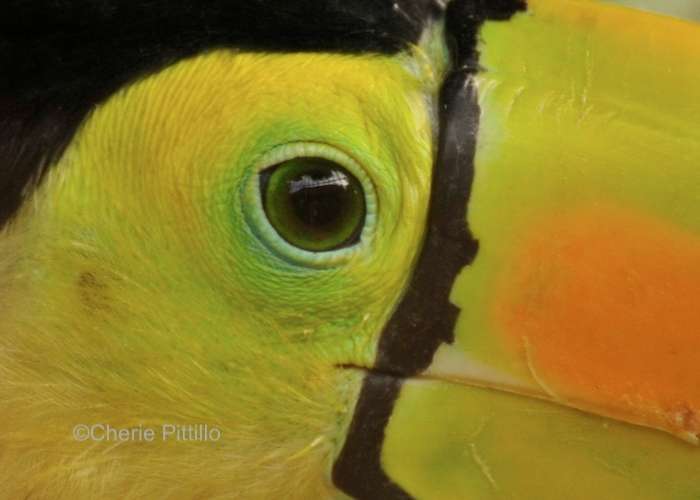
That something as insignificant as an eyelid had its place in the workings on the universe, that the cosmic order did not overlook this momentary fact.
-Haruki Murakami
But maybe many scientists have.
-Cherie Pittillo

Upon closer inspection of a bird’s eye, is the color around the eye the eye-ring or eyelid or both? Check out this White-crowned Sparrow above. Remember that the eyelid, sometimes called the orbital ring, consists of folds of skin. In this sparrow the eyelids are actually gray and adjacent to them are white feathered eye-rings. Unfortunately some references also call the eye-rings orbital rings. And to top that off, references use “eye ring,’’ “eyering” and “eye-ring.” How confusing!
EYE-RINGS
Eye-rings, adjacent to some eyelids, are teeny, tiny feathers, typically without a shaft, that may surround the eye in a circle, or create a crescent, a broken circle, or an arc. Note the broken circular white eye-ring of the Northern Parula below along with the complete eye-ring of the Least Sandpiper. Also these small feathers typically don’t move like other bigger, longer feathers. (I wonder if aggressive birds could move their eye arcs, if they would be “arc enemies.” Have you raised your eyebrows yet?)



Because of their color and location, eye-rings may assist as a field mark in bird identification not only for humans but also serve as visual signals to birds of the same species. They may signal various information between individuals. Some may suggest age or health of an individual bird. Others may appear only when ready to breed. And some birds may not be able to breed depending on their eye-ring color. I wonder if this male bunting hasn’t fully developed its breeding plumage since the eye-ring lacks some red feathers.

Also, sometimes the eye-rings seem lacking such as in the Sandhill Crane and the flamingo feathers below its eye.


To summarize Parts 1* and 2, scientists do agree that birds have eyelids with the “third eyelid” called the nictitating membrane. This membrane cleanses, moistens, and protects the eye for example during swimming, preening, and diving, chasing prey in the air or through shrubs/trees, feeding aggressive young, and during fights.


In many species the eyelids and eye-rings are distinct and in others not so much or the eye-rings don’t exist.




Most diurnal birds have lower lids that come up higher than the upper lid.
Eyelid colors can vary between individuals, geographic location, time of year, and age.
Eye-rings may signal age, health, sexual maturity, or individual markings in many birds and possibly across different populations of birds.
Although I didn’t mention earlier that many bird species have ultra-violet (UV) vision, it seems that colors of eyelids and eye-rings, could be more profound than what research has indicated or even ignored.
Along these lines here is an email excerpt from Friend Charlotte after she read Part 1:
“Nictitating Membrane: another thought I had–could it be used in diving and underwater birds as not only windscreen, but as a UV filter? Like polarizing sunglasses? Would help seeing while going into bright reflective water, and underwater, might even aid in better vision. And actually for all birds it would act as UV protection, esp. when they need to keep their eyelids open a lot to watch for predators. Standing next to my ducks who are “sleeping”, they really aren’t but are watching me closely, even though I am standing with my back against the sun–“difficult” lighting conditions for sure. I often put on a UV filter when photographing sky, esp. shooting directly into the sun, without it, would be very difficult to “see”…”
MY CONCLUSION:
Science has more to investigate; this column provides enough information to form several hypotheses. I call it “eyedroppers!”
SPECIES MENTIONED IN PART 1
Keel-billed Toucan, Ramphastos sulfuratus, Tucán Pico Canoa (Spanish) Pito real (Mayan)
White-crowned Sparrow, Zonotrichia leucophrys, Corrión Blanca (Spanish),
Northern Parula, Setophaga americana, Chipe Pecho Manchado (Spanish_
Least Sandpiper, Calidris minutilla, Playero Diminuto (Spanish)
Canada Warbler, Cardelina canadensis, Chipe de Collar (Spanish)
Painted Bunting, Passerina ciris, Colorin Sietecolores (Spanish)
Sandhill Crane, Antigone canadensis, Grus Canadiense (Spanish)
American Flamingo, Phoenicopterus ruber, Flamenco Americano (Spanish), Mekoh (Mayan)
Reddish Egret, Egretta rufescens, Garza Rojiza (Spanish), Chak bok (Mayan)
Wood Stork, Mycteria americana, Cigüeña Americana o Galletán (Spanish)
Golden-fronted Woodpecker, Melanerpes aurifrons, Carpenter Cheje (Spanish), Ch’ejum, Ch’ ajum Ch’ujum (Mayan)
Great Kiskadee, Pitangus sulphuratus, Luis Bienteveo (Spanish), X tacky (Mayan)
Common Pauraque, Nyctidromus albicollis, Chotacabras Pauraque (Spanish), Pu’ujuy (Mayan)
**Pyrrhuloxia, Cardinalis sinuatus, Cardenal Desértico (Spanish)
(This is a bird species where it’s easier to pronounce the scientific name than the common name! I’ve been eyeing it in reference books for years and finally photographed one near the Mexican border. And yes, it is closely related to the Northern Cardinal.)
GO INTO NATURE AND RELISH HAVING AN “EYE BALL!”
DISCLAIMER: References do not agree about this information.
Email correspondence with Barbara MacKinnon de Montes
Email correspondence with Charlotte Watts
Sal a Pajarear, A Guide to the Birds of Mexico and Northern Central America, Birds and Reserves of the Yucatan Peninsula, Warblers of the Great Lakes Region & Eastern North America, Kaufman Field Guide to Birds of North America, Ornithology in Laboratory and Field, Owls of the World, pg 42, The Life of Birds, The Wonder of Birds
https://www.thespruce.com/identifying-bird-lores-385299
http://wikipedia.us.nina.az/wiki/Eye-ring
https://wikies.wiki/wiki/en/Eye-ring
https://www.birdwatchingdaily.com/birds/david-sibleys-id-toolkit/david-sibley-explains-eye-rings/
https://birdsoftheworld.org/bow/species/pyrrhu/cur/introduction
https://birdsoftheworld.org/bow/species/doccor/cur/appearance
http://people.eku.edu/ritchisong/birdbrain2.html
https://www.karger.com/Article/Abstract/46499
https://www.florida-ecology.com/nictitating-membranes
http://www.hiltonpond.org/ThisWeek030422.html
https://academic.oup.com/iob/article/2/1/obaa048/6064152
https://birdsofseabrook.app.clemson.edu/taxa/t082-caprimulgids.html
https://www.audubon.org/news/birds-have-built-goggles
https://journeynorth.org/tm/spring/OwlFacts.html
https://archives.evergreen.edu/webpages/curricular/2011-2012/m2o1112/web/birds.htm
https://www.azquotes.com/quotes/topics/eyelids.html?p=2
Cherie Pittillo, “nature inspired,” photographer and author, explores nature everywhere she goes. She’s identified 56 bird species in her Merida, Yucatan backyard view. Her monthly column features anecdotes about birding in Merida, Yucatan and also wildlife beyond the Yucatan.
Contact: [email protected] All rights reserved, ©Cherie Pittillo
